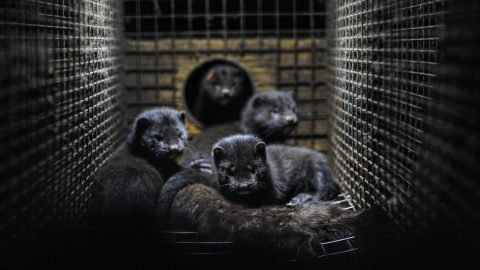At the time of this writing, the world is looking in anticipation at Arizona where the lead of presidential candidate Joe Biden against incumbent Donald Trump narrows and the prospect of a contested election grows. Meanwhile 9000 kilometers away in Copenhagen, Danish prime minister Mette Frederiksen declared that all minks in the country will killed to control to curb the spread of a new SARS-CoV-2 variant.
The reason? The vaccines currently in development could be less effective at combating this new mutation. A Black Swan event is something that comes without warning and can have enormous effects on financial markets and society. Now we may be dealing with a Black Mink event. How did it come about?
Minks and the reservoir of viruses
Minks have long been known to be a potential reservoir of emerging viruses and the first cases of SARS-CoV-2 in minks have been detected in early summer 2020 leading to the cull of large mink populations in Spain and the Netherlands. Denmark, the world’s largest exporter of mink fur, has held back on announcing culls due to the relatively larger importance of the industry, which accounts for 0.7% of the country’s exports.
Mink fur is sought after in the Chinese apparel industry, while the fur is shunned in most Western countries. A so called “crossover” event has now pushed the Danish government into action. The cull will lead to the death of 17 million minks in roughly 1000 farms at the cost of more than EUR 700 million.
Aided by seabirds
Recently, SARS-CoV-2 has spread in Danish mink farm populations, potentially aided by seabirds carrying the virus in mink feces on their feet from farm to farm. The virus has mutated in the mink host and crossed back into the human population. Government officials estimate that roughly 5% of all active Covid cases in the Northern Jutland region (a sparsely populated region with a population size comparable to Carinthia) are caused by the mutated variant.
Some media outlets report that the variant has emerged as far away as Croatia, however, confirmation of this claim is difficult. The mutation in the variant concerns the spike protein on the outside of the virus. Unfortunately, this is exactly the part of the virus that allows most of the vaccines currently in development to be effective.
While the Danish Serum Institute found that antibodies from convalescent Covid patients are less effective at neutralizing the new variant with 4 mutations in the spike protein, there is no reason to believe that the cellular immunity granted by T and B cells will not be able to detect and destroy the new variant. However, the concern is that the new variant will spread and become the dominant variant while picking up further mutations on the spike protein (SARS-CoV-2 picks up one mutation in its 28,883 genes roughly every 16 days – slow compared to other viruses) to the point where even cellular immunity is ineffective.
A bouncer at a night club
To illustrate this rather complex problem, imagine a bouncer at a night club tasked to filter out troublemakers. From experience the bouncer (antibodies) knows that guests wearing red ties (spike protein) are trouble. All is well until the troublemakers decide to now wear green ties (mutated spike protein). The bouncer may see the green ties and suspect something is wrong, so he calls the head of security (B and T cells), who, after interviewing the guest in the green tie, determines that he is indeed a troublemaker.
The club stays safe, but head of security will have to check everyone with a green tie in the future. The troublemakers really want to get into the club and now decide to wear green socks (potential future spike protein mutation). In that case, the bouncer will not be suspicious and call the head of security. The troublemakers make it into the club and cause a fight (disease breaks out).
Conclusion
In summary, the events in Denmark have the potential to seriously prolong the ongoing pandemic, if the new variant is allowed to spread uncontrolled. If it became dominant and mutated further, new vaccines would have to be developed, which would be a tedious yet easier task than the first time around.
The Danish governments has apparently recognized the severity of the situation and has taken the necessary painful steps. Industrial farming of susceptible animals – mink farming still continues in the US, Canada and China – still poses a significant downside risk and will continue to be a hotbed for future pandemics.
Everything about the Coronavirus: https://blog.en.erste-am.com/dossier/coronavirus/
Legal note:
Prognoses are no reliable indicator for future performance.
Legal disclaimer
This document is an advertisement. Unless indicated otherwise, source: Erste Asset Management GmbH. The language of communication of the sales offices is German and the languages of communication of the Management Company also include English.
The prospectus for UCITS funds (including any amendments) is prepared and published in accordance with the provisions of the InvFG 2011 as amended. Information for Investors pursuant to § 21 AIFMG is prepared for the alternative investment funds (AIF) administered by Erste Asset Management GmbH pursuant to the provisions of the AIFMG in conjunction with the InvFG 2011.
The currently valid versions of the prospectus, the Information for Investors pursuant to § 21 AIFMG, and the key information document can be found on the website www.erste-am.com under “Mandatory publications” and can be obtained free of charge by interested investors at the offices of the Management Company and at the offices of the depositary bank. The exact date of the most recent publication of the prospectus, the languages in which the fund prospectus or the Information for Investors pursuant to Art 21 AIFMG and the key information document are available, and any other locations where the documents can be obtained are indicated on the website www.erste-am.com. A summary of the investor rights is available in German and English on the website www.erste-am.com/investor-rights and can also be obtained from the Management Company.
The Management Company can decide to suspend the provisions it has taken for the sale of unit certificates in other countries in accordance with the regulatory requirements.
Note: You are about to purchase a product that may be difficult to understand. We recommend that you read the indicated fund documents before making an investment decision. In addition to the locations listed above, you can obtain these documents free of charge at the offices of the referring Sparkassen bank and the offices of Erste Bank der oesterreichischen Sparkassen AG. You can also access these documents electronically at www.erste-am.com.
Our analyses and conclusions are general in nature and do not take into account the individual characteristics of our investors in terms of earnings, taxation, experience and knowledge, investment objective, financial position, capacity for loss, and risk tolerance. Past performance is not a reliable indicator of the future performance of a fund.
Please note: Investments in securities entail risks in addition to the opportunities presented here. The value of units and their earnings can rise and fall. Changes in exchange rates can also have a positive or negative effect on the value of an investment. For this reason, you may receive less than your originally invested amount when you redeem your units. Persons who are interested in purchasing units in investment funds are advised to read the current fund prospectus(es) and the Information for Investors pursuant to § 21 AIFMG, especially the risk notices they contain, before making an investment decision. If the fund currency is different than the investor’s home currency, changes in the relevant exchange rate can positively or negatively influence the value of the investment and the amount of the costs associated with the fund in the home currency.
We are not permitted to directly or indirectly offer, sell, transfer, or deliver this financial product to natural or legal persons whose place of residence or domicile is located in a country where this is legally prohibited. In this case, we may not provide any product information, either.
Please consult the corresponding information in the fund prospectus and the Information for Investors pursuant to § 21 AIFMG for restrictions on the sale of the fund to American or Russian citizens.
It is expressly noted that this communication does not provide any investment recommendations, but only expresses our current market assessment. Thus, this communication is not a substitute for investment advice.
This document does not represent a sales activity of the Management Company and therefore may not be construed as an offer for the purchase or sale of financial or investment instruments.
Erste Asset Management GmbH is affiliated with the Erste Bank and austrian Sparkassen banks.
Please also read the “Information about us and our securities services” published by your bank.

